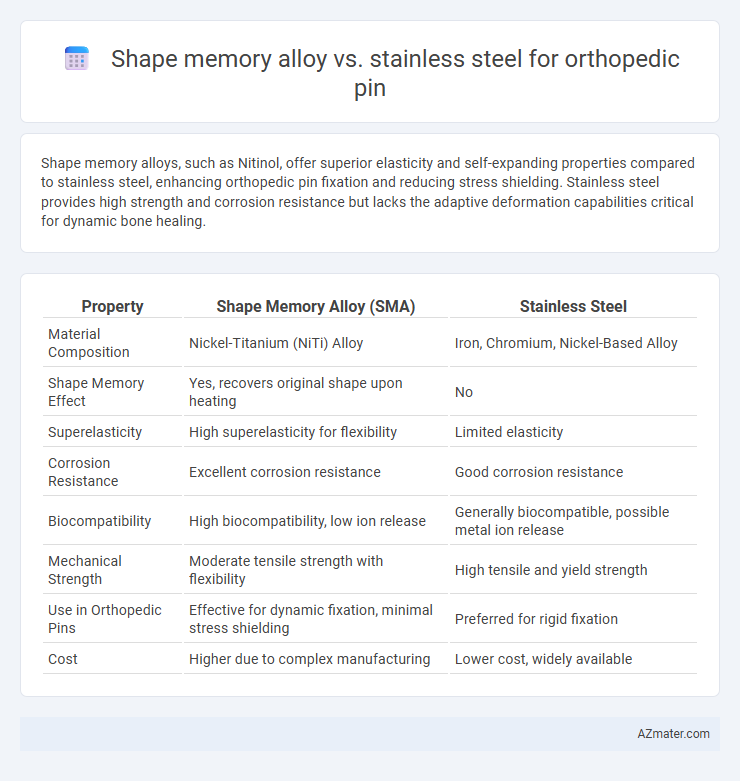Shape memory alloys, such as Nitinol, offer superior elasticity and self-expanding properties compared to stainless steel, enhancing orthopedic pin fixation and reducing stress shielding. Stainless steel provides high strength and corrosion resistance but lacks the adaptive deformation capabilities critical for dynamic bone healing.
Table of Comparison
| Property | Shape Memory Alloy (SMA) | Stainless Steel |
|---|---|---|
| Material Composition | Nickel-Titanium (NiTi) Alloy | Iron, Chromium, Nickel-Based Alloy |
| Shape Memory Effect | Yes, recovers original shape upon heating | No |
| Superelasticity | High superelasticity for flexibility | Limited elasticity |
| Corrosion Resistance | Excellent corrosion resistance | Good corrosion resistance |
| Biocompatibility | High biocompatibility, low ion release | Generally biocompatible, possible metal ion release |
| Mechanical Strength | Moderate tensile strength with flexibility | High tensile and yield strength |
| Use in Orthopedic Pins | Effective for dynamic fixation, minimal stress shielding | Preferred for rigid fixation |
| Cost | Higher due to complex manufacturing | Lower cost, widely available |
Introduction to Orthopedic Pins
Orthopedic pins serve as essential fixation devices designed to stabilize fractured bones, ensuring proper alignment during healing. Shape memory alloys, particularly Nitinol, offer unique properties such as superelasticity and thermal shape memory, providing dynamic support and reduced invasiveness in bone fixation. In contrast, stainless steel pins deliver high strength and corrosion resistance but lack the adaptive flexibility of shape memory alloys, often resulting in a more rigid fixation approach.
Overview of Shape Memory Alloys
Shape memory alloys (SMAs), such as Nitinol, exhibit unique properties like superelasticity and the ability to return to their original shape after deformation, making them ideal for orthopedic pins that require flexibility and precise recovery. These alloys offer enhanced biocompatibility, corrosion resistance, and fatigue strength compared to traditional stainless steel, reducing the risk of implant failure and improving patient outcomes. SMAs enable minimally invasive procedures due to their adaptability and shape memory effect, providing dynamic support to bone healing processes.
Characteristics of Stainless Steel Pins
Stainless steel pins used in orthopedic applications exhibit high tensile strength, excellent corrosion resistance, and biocompatibility, making them suitable for long-term implantation. Their rigidity ensures stable fixation of bone fractures, while the cost-effectiveness and ease of sterilization enhance clinical usability. Despite lacking the superelasticity of shape memory alloys, stainless steel pins provide reliable mechanical support without deformation under physiological loads.
Biocompatibility Comparison
Shape memory alloys, primarily nickel-titanium (Nitinol), exhibit superior biocompatibility compared to stainless steel due to their corrosion resistance and reduced ion release, minimizing adverse tissue reactions in orthopedic pins. Stainless steel, commonly 316L grade, may cause localized inflammation or allergic responses because of nickel and chromium ion leaching, impacting long-term implant success. The enhanced elasticity and durability of shape memory alloys contribute to improved patient outcomes by maintaining structural integrity and reducing implant-related complications in orthopedic applications.
Mechanical Properties and Performance
Shape memory alloys (SMAs) exhibit superior mechanical properties such as high elasticity, excellent superelasticity, and the ability to recover original shape after deformation, which enhances orthopedic pin performance by reducing stress shielding and promoting bone healing. Stainless steel offers high tensile strength and corrosion resistance but lacks the flexibility and stress adaptation properties of SMAs, potentially leading to higher rigidity and decreased patient comfort. The unique pseudoelastic behavior of SMAs provides improved load distribution and reduces risks of implant failure compared to the more traditional, stiffer stainless steel pins.
Corrosion Resistance and Longevity
Shape memory alloys, such as Nitinol, exhibit superior corrosion resistance compared to stainless steel due to the formation of a stable titanium oxide layer that prevents degradation in the physiological environment. Stainless steel, particularly 316L grade, offers good corrosion resistance but is more susceptible to pitting and crevice corrosion under body fluid exposure. The enhanced corrosion resistance of shape memory alloys directly contributes to greater longevity and reduced risk of implant failure in orthopedic pins.
Clinical Applications and Outcomes
Shape memory alloy (SMA) orthopedic pins, primarily composed of nickel-titanium, provide superior flexibility and biocompatibility compared to stainless steel, enhancing patient outcomes in fracture fixation and bone stabilization. Clinical applications of SMA pins include minimally invasive procedures where their superelasticity reduces stress shielding and allows for dynamic load sharing during healing. Studies report improved bone healing rates, reduced implant migration, and fewer complications with SMA pins versus traditional stainless steel counterparts, which are favored for their rigidity and corrosion resistance but may lead to higher rates of stress shielding and discomfort.
Cost and Availability Considerations
Shape memory alloys generally have higher costs compared to stainless steel due to advanced manufacturing processes and material properties, affecting their affordability for widespread use in orthopedic pins. Stainless steel remains more readily available and cost-effective, making it the preferred choice in many healthcare settings, especially in resource-limited environments. The balance between cost-efficiency and material performance plays a crucial role in selecting the appropriate orthopedic pin material.
Advances and Innovations in Materials
Shape memory alloys (SMAs) in orthopedic pins offer superior biocompatibility and enhanced mechanical properties, including superelasticity and shape recovery, which improve implant stability and reduce surgical trauma. Innovations in nickel-titanium (NiTi) SMAs have led to coatings and surface treatments that enhance corrosion resistance and reduce ion release compared to traditional stainless steel pins. Ongoing research emphasizes nano-engineered SMA composites and additive manufacturing techniques that optimize stress distribution and promote faster osseointegration, surpassing conventional stainless steel in long-term implant performance.
Conclusion: Choosing the Optimal Material
Shape memory alloys exhibit superior flexibility, biocompatibility, and corrosion resistance compared to stainless steel, making them ideal for dynamic orthopedic pins requiring adaptability and long-term performance. Stainless steel offers high strength, cost-effectiveness, and widespread clinical use, suitable for applications demanding rigidity and structural support. Selecting the optimal material depends on balancing mechanical demands, patient-specific factors, and the clinical environment to optimize healing outcomes.

Infographic: Shape memory alloy vs Stainless steel for Orthopedic pin
 azmater.com
azmater.com